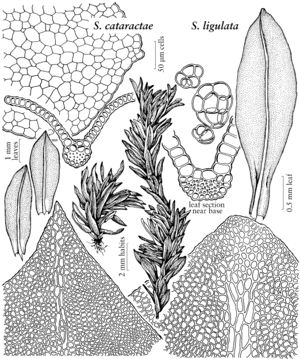Scopelophila
Acta Soc. Sci. Fenn. 10: 269. 1872 ,.
| Taxon | Illustrator ⠉ | |
|---|---|---|
 | Scopelophila cataractae Scopelophila ligulata | Patricia M. Eckel Patricia M. Eckel |
Plants forming a thin or thick turf, green to greenish yellow or brown distally, blackish or weakly iridescent to metallic tan or yellowbrown proximally. Stems to 4 cm, rounded-pentagonal in transverse-section, hyalodermis absent, sclerodermis absent, central strand absent; axillary hairs 3–5 cells in length, proximal cell usually brownish. Cauline leaves often crowded, incurved to spreading, contorted, carinate, occasionally with undulating margins when dry, spreading when moist; lingulate to ligulate or oblanceolate, widest at mid leaf or beyond, adaxial surface narrowly and deeply grooved along costa or broadly channeled, to 2.5 mm; base scarcely differentiated in shape to long-elliptic, occasionally medially constricted, proximal margins occasionally slightly decurrent; distal margins plane or somewhat recurved proximally, entire to minutely crenulate or denticulate distally, often bordered by a few rows of thicker walled cells distally; apex broadly acute or obtuse, often with a broad apiculus, occasionally rounded; costa slender, percurrent or ending 2–8 cells before the apex, occasionally excurrent as a short mucro, adaxial outgrowths absent, adaxial cells quadrate to rectangular, in 2–4 rows; transverse-section semicircular to round, adaxial epidermis absent or present, adaxial stereid band absent, guide cells 2 (–4) in 1 layer, hydroid strand absent, abaxial stereid band present, rounded in sectional shape, abaxial epidermis present, usually very distinct; proximal cells differentiated across leaf, extending higher medially, rectangular, occasionally inflated, scarcely wider than distal cells to inflated, 2–3: 1, walls of proximal cells hyaline or deep brown; distal medial cells rounded-quadrate to hexagonal or shortrectangular, ca. 8–14 µm, often heterogeneous in size, 1 (–2):1, 1-stratose; papillae usually lacking, occasionally low-verrucose, cell-walls thin to evenly thickened, thicker near margins, flat or somewhat bulging on adaxial surface. Specialized asexual reproduction rare, on stalks from the stem, greenish brown, clavate to ellipsoid or filamentous and branching, ca. 12 µm, of 2 or more rounded cells. Sexual condition dioicous. Perichaetia terminal, interior leaves little differentiated. [Seta 2–6 mm. Capsule stegocarpous, theca shortly elliptic to cylindric, macrostomous, 0.6–2.2 mm, annulus weakly differentiated or of 1–4 rows of vesiculose cells, deciduous in fragments; operculum conic-rostrate, erect or oblique; peristome teeth absent. Calyptra cucullate. Spores 8–13 µm.] KOH distal laminal color reaction yellow to yellowish orange.
Distribution
North America, Mexico, Central America, South America, Europe, Asia, c Africa, Pacific Islands (Hawaii)
Discussion
Species 3 (2 in the flora).
Scopelophila is a small genus (R. H. Zander 1993) of “copper mosses” (see reviews by A. J. Shaw and L. E. Anderson 1988; Shaw 1993) associated with mineralized soils. Crumia is similar but is quickly distinguished by its stem central strand, intramarginal laminal border, and distal laminal cells usually distinctly papillose.
Selected References
Lower Taxa
Key
| 1 | Stems often red-tomentose; proximal leaves brown; leaves acute or short-acuminate, usually not bordered; costa with 2 layers of parenchymatous cells adaxial to the stereid band. | Scopelophila cataractae |
| 1 | Stems with sparse brownish rhizoids; proximal leaves brownish black; leaves obtuse to acute, often apiculate by a single cell, usually bordered by thick-walled cells (at least in older leaves); costa with 1 layer of parenchymatous cells adaxial to the stereids. | Scopelophila ligulata |